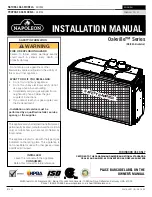
FOTO9S4A
ENGLISH
ISFT9S4AEU_08_04.doc
1. DESCRIPTION
FOTO9S4A
is a 4-beam photocell amplifier especially designed, engineered, and constructed to ensure, when used in conjunction with appropriate
sensors, maximum safety for automatic accesses such as lift doors, burglar-proof double doors, automatic, overhead and industrial doors, and so on. The
device can be mounted by positioning the sensors either directly in the doorway or inside one or more safety hips. Built to European reference standards,
features “
redundant electronics”.
2. MAIN
FEATURES
•
Very high noise immunity thanks to a multiplexed and synchronised system.
•
Management of four selectable beams.
•
Two relay outputs (NO/NC).
•
Easy installation and alignment of sensors thanks to the trimmer-controlled infrared beam
intensity dimming function.
•
Possibility of combination with Prastel’s sensor models:
CR9MS, CR9MS9, CR9MSD, CR9MSP,
CRFC, CR20MS.
•
Compliance with European reference
3. TECHNICAL
FEATURES
Power supply
12-24 Vac/dc ± 10%
Maximum power input
1.5W at 12Vac – 3.0W at 24Vac
Maximum current input
110mA (4 enabled beams)
Infrared wave length
850 nm
Rated range
2 to 20 m
Relay outputs (clean exchange contact)
NO/NC
Relay time delay
50 ms or 500 ms (selectable)
Reset time
0.5 sec
Operating temperature
-20 to + 55 °C
Dimensions/Weight
110 x 75 x 35 mm / 420 g.
4. WIRING
AND
START-UP
•
Before installing the FOTO9S4A photocell amplifier, carefully read the “General Safety Precautions”.
•
Install the box via the appropriate mounting holes.
•
Align the sensors.
•
Route the connection cables through the appropriate slots. Connect the power and signal cables.
Note: To link up the transmitter sensors, connect the middle wire (red) to the common TX terminal and the braiding to terminals 1, 2, 3 or 4. To
link up the receiver sensors connect the braiding to the common RX terminal and the middle wire (white) to terminals 1, 2, 3 or 4.
•
Enable the beams to be used by setting the four-contact
SW1
dip-switch to ON.
•
Power and check that the
red LED
corresponding to each enabled beam is OFF.
LED ON
= beam broken or not enabled
LED OFF
= beam aligned and not broken.
•
Select operating mode by setting each of the four contacts of dip-switch
SW2
as follows:
- 1 (P) to ON for maximum beam intensity and for cutting out the TR1 fine adjustment potentiometer
to off to enable the TR1 potentiometer for the fine adjustment of beam dimming
- 2 (T) to ON to select short time delay (50 msec)
to OFF to select long time delay (500 msec)
- 3 (F) and 4 (F)
to select association of the beams to the two outputs as shown in the following table:
Contact 3 (F)
Contact 4 (F)
Activation of output 1
Activation of output 2
ON
ON
OR of RX1, RX2 (*)
OR of RX3, RX4 (*)
ON
OFF
OR of RX1, RX2, RX3,RX4
Not active
OFF
ON
OR of RX1, RX2, RX3
RX4
OFF
OFF
AND of RX1, RX2 (**)
AND of RX3, RX4 (**)
(*) OR indicates that only one broken beam is sufficient for activation of the corresponding output.
(**) AND indicates that all beams must be broken for activation of the corresponding output.
WARNING
•
The amplifier is set up to the minimum beam range: act on potentiometer TR1 to adjust beam intensity. To enable the potentiometer, set dip-
switch SW2 (contact 1P) to OFF. With cursor completely turned clockwise, range is minimum (i.e., beams are dimmed down to a minimum);
when completely turned counterclockwise, range is at a maximum (i.e., beams are undimmed). The following table shows maximum range for a
CR9MS sensor as a function of the cursor position of the TR1 trimmer.
Cursor position TR1 Trimmer
Max
7/8 6/8 5/8 4/8 3/8 2/8 1/8 Min.
Indoor range with CR9MS
sesnors (m)
9 7.5 6 5 4 3 2.5 2 1.5
•
Press the TEST button to check that amplifier is working properly. If beams are properly aligned (i.e., red LEDs off), pressing of the button disables the
individual beams so that if the amplifier is working correctly, the red LEDs will come on and stay on as long as the button is kept pressed.
•
Depending on the setting of dip-switch SW2, check for proper operation via green LEDs LD1 and LD2 which indicate the status of the two outputs (LED on
= output not active, LED off = output active).
•
When used in conjunction with “intelligent” units (for example units of Prastel’s Euromatic family) and for compliance with Machine Directive 98/37/CE, send
an impulse (10-30Vdc) of a minimum of 70 msec via the TEST input in the terminal strip. This will cause the FOTO9S4A to activate the outputs thus
signalling that the system is working correctly.
The FOTO9S4A device must be installed inside another casing that features an IP rating of at least X4. The inside of the casing must be accessible
by means of appropriate tools.
The photocell is an auxiliary device for the detection of persons and/or objects and must therefore be used in conjunction with a security device.
The photocell must be subjected to periodical checks at least once every 6 months.


























